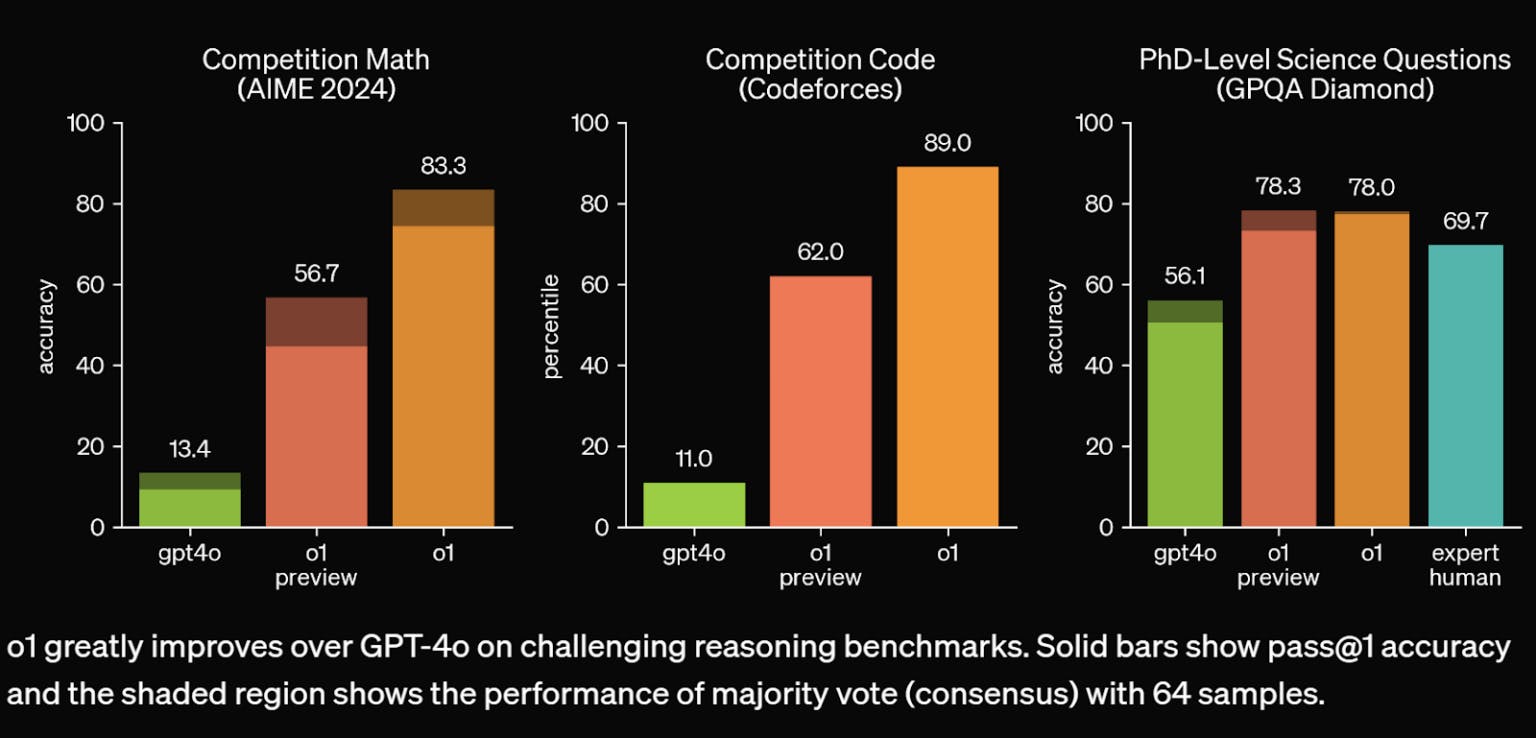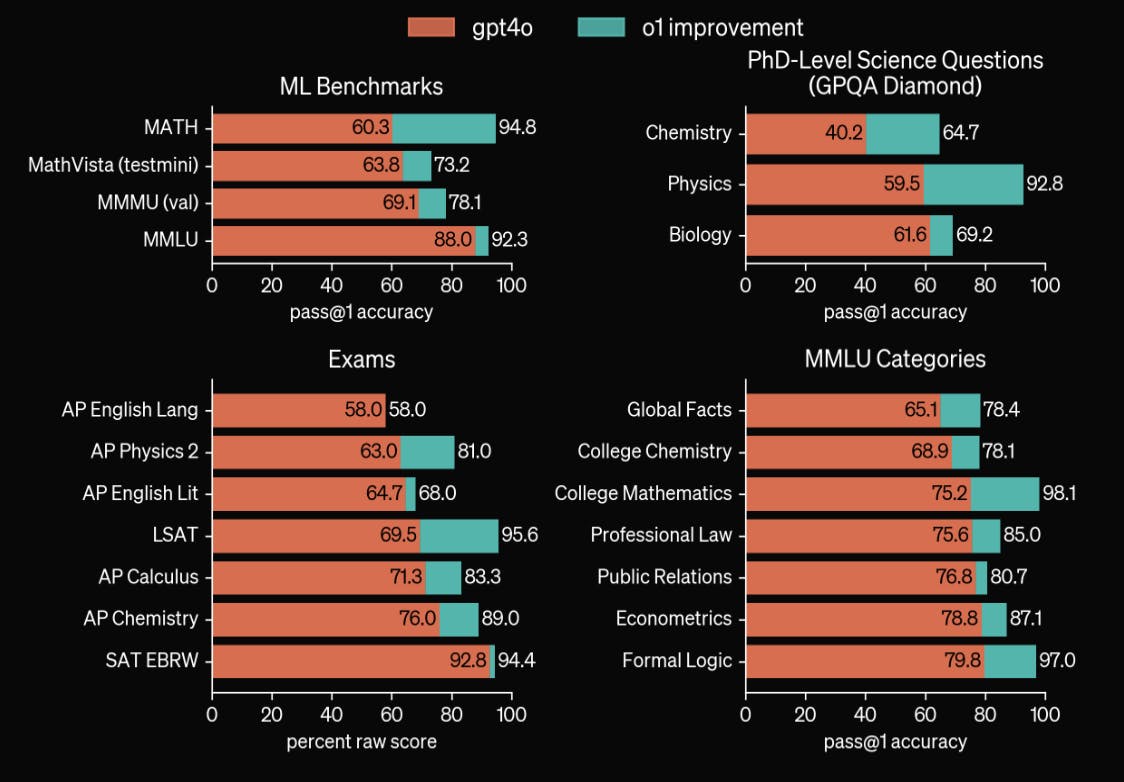Table of contents :
OpenAI o1: everything you need to know?
OpenAI o1, formerly known as Strawberry, is the new AI model launched by OpenAI. This new milestone builds on advanced reasoning capabilities and enhanced precision performance to provide solutions across various sectors. But what exactly is OpenAI o1, and why is it essential for the future of AI?
What is OpenAI o1?
OpenAI o1 is a pre-trained generative language model designed to excel in complex tasks requiring deep reasoning. Unlike its predecessors, o1 spends more time "thinking" before responding. This makes it particularly effective for tackling difficult problems in fields such as science, mathematics, and programming. As a successor, it brings significant improvements in natural language understanding and analysis.
The evolution of Openai
Each new model from OpenAI, integrated into Swiftask, the AI assistant, has introduced enhanced features in language processing and contextual understanding, solidifying OpenAI's position as a leader in the AI field. Here’s an overview of the key milestones and characteristics of this evolution:
- GPT-1: Released in 2018 with 117 million parameters, GPT-1 marked the beginning of OpenAI's efforts. It demonstrated the effectiveness of transfer learning in the field of natural language processing (NLP).
- GPT-2: With its 1.5 billion parameters in 2019, it marked a breakthrough by generating more fluent and coherent text, but OpenAI initially limited its access due to the risks associated with its use.
- GPT-3: Introduced in 2020 with 175 billion parameters, it revolutionized language applications by enabling the execution of a multitude of complex tasks with few prior learning examples.
- GPT-4: Launched in 2023, it significantly enhances advanced reasoning and precision capabilities compared to its predecessors while introducing multimodal functions to process both text and images.
- GPT-o1: Designed to address needs in complex reasoning and scientific and technical problem-solving, it was launched in September 2024.
The main objectives of OpenAI o1
OpenAI O1, the AI agent, aims to enhance the AI's ability to reason more like a human and process complex information. The model seeks to increase the efficiency of your businesses across various fields by optimizing processes and facilitating decision-making. It is designed to minimize hallucinations or incorrect responses, providing a more thoughtful approach and more reliable answers to your inquiries, thereby significantly reducing the risk of errors.
OpenAI offers you a model that sets new standards. This model has been developed to meet the growing needs in sectors such as scientific research, healthcare, and software development. As a result, you can leverage OpenAI o1 for complex tasks such as data annotation or generating advanced mathematical formulas.
How OpenAI o1 learns and evolves
OpenAI o1 relies on advanced machine learning techniques, particularly deep learning for unsupervised learning, and reinforcement learning, which allows it to improve its performance through trial and error. Through exposure to massive volumes of data, o1 continuously refines its reasoning and problem-solving capabilities, with regular updates that address its limitations and optimize its skills.
Moreover, GPT-o1 incorporates a chain of thought, a structured process that enables it to break down and analyze complex problems before generating responses, thereby increasing the accuracy and relevance of its results
Sectors most likely to benefit from model o1
Sectors such as finance, healthcare, e-commerce, and digital marketing are the first to benefit from OpenAI o1. With its advanced data processing capabilities, o1 can analyze complex information on a large scale. This allows your businesses to optimize their operations while improving the accuracy of their decisions.
How to optimize your prompts to get the most out of OpenAI o1?
To maximize the effectiveness of your interactions with o1, it is essential to adopt strategies for optimizing your prompts. By doing so, you can enhance the clarity of your requests and receive more relevant and tailored responses to your needs. Consider these practical tips:
- Be direct: Use clear and concise instructions. The o1 models are designed to effectively interpret short prompts without the need for excessive details.
- Avoid chain of thought techniques: Do not include instructions asking the model to think step by step. It already performs this reasoning internally.
- Use constraints: When requesting a response, impose limits or criteria (such as word count, style, or tone) to guide the response and achieve a result that meets your needs.
- Reduce additional context: In the context of retrieval-augmented generation (RAG), providing too much contextual information can lead to a more complex response from the model.
The importance of advanced reasoning for You
In-depth analysis is one of the main strengths of OpenAI o1. But why is it essential for you, whether as a business or an individual user? With its reasoning capabilities, o1 enables the resolution of complex problems and the analysis of situations at multiple levels of complexity.
Reasoning mechanisms
OpenAI currently offers two models in the o1 series:
- o1-preview: Designed to excel in complex tasks requiring extensive knowledge of various aspects of the world.
- o1-mini: A more accessible and efficient version of the series, ideal for coding, mathematics, and science tasks.
The o1 models are built on a common knowledge base with GPT-4. They feature impressive input capabilities with a context window of 128,000 tokens. Regarding output generation, o1-preview can produce up to 32,768 tokens, while o1-mini has the potential to reach 65,536 tokens.
OpenAI has integrated the chain of thought mechanism into its models, an approach that encourages them to reason sequentially before arriving at a response. This method is designed to enhance the quality of answers by promoting deeper thinking. Many language model providers (LLMs) have adopted this technique, and the impact is evident: instead of producing complete textual responses, some models, like GPT-4o, now prefer to provide answers in list format. This reflects an evolution in how prompts are formulated during the fine-tuning phase.
Reinforcement learning is also essential in this process. This method allows models to optimize their outputs by rewarding correct answers while penalizing incorrect ones. Through this approach, OpenAI teaches its models to think more productively, optimizing the learning process with an algorithm that utilizes a chain of thought.
Real-world applications of advanced reasoning in OpenAI o1
The advanced reasoning capabilities of OpenAI o1 pave the way for various practical applications across multiple sectors. Here are some significant examples:
- Scientific research: o1 can analyze complex data, formulate hypotheses, and even generate mathematical models. This allows researchers to accelerate the analysis process and explore new ideas.
- Software development: With its reasoning capabilities, o1 assists in generating code and identifying errors. This enhances developers' efficiency by automating certain tasks and providing correction suggestions.
- Healthcare: In the medical field, o1 is used to interpret test results, recommend treatments based on patient data, and even assist healthcare professionals in diagnosis.
- Finance: Models like o1 can analyze market trends, predict fluctuations, and provide strategic recommendations based on complex financial data.
- Education: As an educational tool, o1 can personalize learning according to students' needs, offering resources and exercises tailored to their understanding levels.
In areas such as medical diagnosis, financial risk management, and logistical planning, the advanced reasoning of OpenAI o1 simplifies and optimizes complex decision-making processes.
Precision and performance: what it means for you
Beyond reasoning, OpenAI o1 excels in precision. This level of performance radically changes how your businesses manage automated processes.
Why is the precision of OpenAI o1 an asset for your business?
The precision of OpenAI o1 is a true asset for you and your business. It enables you to make informed decisions by providing analyses and recommendations based on reliable data. This reduces the risks associated with your strategic choices and optimizes your operations by appropriately adjusting your resources and strategies.
Moreover, accurate responses enhance customer satisfaction, loyalty, and overall experience. By simplifying the resolution of complex tasks, OpenAI o1 also helps you innovate, allowing your teams to focus on creative solutions rather than wasting time managing errors.
Finally, this precision contributes to cost reduction by minimizing the number of mistakes, saving you time, resources, and providing a competitive advantage. In summary, the precision of OpenAI o1 extends beyond individual results; it has a direct impact on the overall performance of your business.
The o1 model compared to other models
Compared to other AI models, OpenAI o1 stands out for its advanced reasoning capabilities, allowing it to tackle complex tasks with superior analytical depth.
Source: bind AI

The graph shows a significant improvement of the OpenAI o1 model compared to GPT-4o in several areas of complex reasoning, including mathematics, coding, and PhD-level scientific questions. In the math competition (AIME 2024), GPT-4o achieves only 13.4% accuracy, while o1-preview progresses to 56.7%, and o1-final reaches 83.3%. This demonstrates the enhanced capability of the o1 model to solve advanced mathematical problems.
In the field of programming (Codeforces), GPT-4o has a low score of 11%, while o1-preview rises to 62%, and o1-final climbs to 89%. This indicates that o1 is significantly more effective at solving complex programming challenges. For PhD-level scientific questions, GPT-4o achieves 56.1%, whereas o1-preview and o1-final increase to around 78%, even surpassing the average human performance (69.7%).
Source: bind AI

ML Benchmarks: In this section, we measure the models' ability to solve complex mathematical problems and understand text. For example, in the "MATH" test, o1 achieves a score of 94.8%, significantly higher than GPT-4o, which scores 60.3%.
Exams: These tests include school subjects such as English, Physics, or Chemistry. For instance, in an AP Physics 2 exam, GPT-4o scores 63%, while o1 reaches 81%.
PhD-level science questions: These tests are extremely challenging, featuring high-level scientific questions (Chemistry, Physics, Biology). Again, o1 shows a marked improvement over GPT-4o, especially in Physics, where it rises from 59.5% to 92.8%.
MMLU categories: These are more general tests on various subjects (such as Chemistry, Mathematics, Law). We see that for most subjects, o1 significantly improves upon GPT-4o's results. For example, in College Mathematics, o1 achieves an impressive score of 98.1%, compared to 75.2% for GPT-4o.
What you can expect from OpenAI o1
Integrating OpenAI o1 into your business processes allows for significant gains in productivity and precision.
A more intuitive AI tailored to your needs
Imagine an artificial intelligence that truly understands your needs. OpenAI o1 is designed to provide an intuitive user experience, adapting to the specifics of your business. With deep learning algorithms, this AI proactively learns, delivering tailored solutions that seamlessly integrate into your professional routine.
With OpenAI o1, you don’t just receive data; you gain relevant recommendations and personalized insights that boost your efficiency. Imagine being able to interact with your AI as naturally as if you were speaking to a colleague. This level of intuitiveness makes adopting this technology simple and accessible for you and your team.
Advanced reasoning for more accurate strategic decisions
One of the major strengths of OpenAI o1 is its ability to perform advanced reasoning. Think about all the strategic decisions you need to make each day. With OpenAI o1, you will have access to in-depth analyses that help you navigate a sea of complex data.
This tool allows you to simulate different scenarios and evaluate their potential impacts. You will be able to make informed decisions, thereby reducing risks and maximizing opportunities. Imagine being able to predict market trends and anticipate your customers' needs even before they express them. This could be your reality with OpenAI o1.
How OpenAI o1 has already transformed industries
Many sectors have already seen their practices revolutionized thanks to OpenAI o1. In the healthcare field, for example, professionals use this technology to diagnose diseases more quickly and personalize treatments. In the financial sector, it helps detect fraud in real-time and optimize investments.
But that’s not all! Retail companies leverage OpenAI o1 to provide a tailored customer experience by recommending products based on past purchasing behaviors. In summary, OpenAI o1 is not just a tool; it is a catalyst for transformation that could redefine your industry.
How to integrate OpenAI o1 into your business processes?
So, how can you leverage this technology in your company? The key lies in strategic integration. Start by identifying areas where OpenAI o1 can make a difference: automating repetitive tasks, improving customer service, or optimizing your supply chain.
Also, invest in training your team. By organizing training sessions and providing educational resources, you will help your employees familiarize themselves with OpenAI o1, maximizing its impact. Don’t forget to establish metrics to evaluate the results obtained and adjust your strategy as needed. By integrating OpenAI o1, you are not just following a trend; you are gaining an edge over your competitors.
Challenges and ethical considerations you should know
Integrating AI models like OpenAI o1 presents ethical challenges, such as managing biases and ensuring transparency.
What are the limitations of o1?
Every tool has its limitations, and OpenAI o1 is no exception. It is essential to keep in mind that the quality of the results depends on the data on which the AI is trained. Biased or incomplete data can lead to erroneous outcomes. Additionally, while the AI is powerful, it may sometimes lack contextual understanding, which can result in incorrect interpretations.
The ethical stakes surrounding the use of OpenAI o1
Ethical questions are paramount in the AI world. It is vital to ensure transparency in data usage. Users must know how their information is collected and utilized. Privacy protection is also essential, especially in sensitive sectors such as healthcare and finance.
Furthermore, it is crucial to ensure that OpenAI o1 does not reproduce existing biases in the data. As a user, you must be aware of the ethical implications of AI and commit to promoting fairness and accountability in its use.
What innovations for OpenAI o1?
To stay at the forefront of innovation, OpenAI o1 must continue to evolve. This includes improving algorithms to provide even more advanced reasoning, broadening language and cultural contexts, and developing customization features.
Imagine a future where OpenAI o1 is not just a tool, but a dynamic partner in your decision-making. This synergy between humans and AI can revolutionize your way of working, helping you reach new heights.
OpenAI o1 is much more than just an artificial intelligence tool; it is an opportunity for you to transform your business. With its adaptability, advanced reasoning, and potential to transform industries, it is time to embrace this technology. By integrating OpenAI o1 thoughtfully and strategically, you are not merely following a trend: you are taking the reins of your future. Don’t miss this chance to evolve your business towards new horizons. Embark on this exciting journey with OpenAI o1 now!
author
OSNI

Published
October 28, 2024